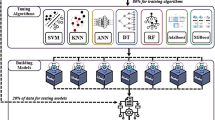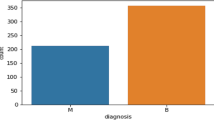Abstract
Methods that can accurately predict breast cancer are greatly needed and good prediction techniques can help to predict breast cancer more accurately. In this study, we used two feature selection methods, forward selection (FS) and backward selection (BS), to remove irrelevant features for improving the results of breast cancer prediction. The results show that feature reduction is useful for improving the predictive accuracy and density is irrelevant feature in the dataset where the data had been identified on full field digital mammograms collected at the Institute of Radiology of the University of Erlangen-Nuremberg between 2003 and 2006. In addition, decision tree (DT), support vector machine—sequential minimal optimization (SVM-SMO) and their ensembles were applied to solve the breast cancer diagnostic problem in an attempt to predict results with better performance. The results demonstrate that ensemble classifiers are more accurate than a single classifier.


Similar content being viewed by others
References
Razavi, A. R., Gill, H., Åhlfeldt, H., and Shahsavar, N., Predicting metastasis in breast cancer: comparing a decision tree with domain experts. J. Med. Syst. 31:263–273, 2007.
Brenner, H., Long-term survival rates of cancer patients achieved by the end of the 20th century: a period analysis. Lancet. 360:1131–1135, 2002.
Nystrom, L., Andersson, I., Bjurstam, N., Frisell, J., Nordenskjold, B., and Rutqvist, L. E., Long-term effects of mammography screening: updated overview of the Swedish randomised trials. Lancet. 359(9310):909–919, 2002.
Bjurstam, N., Bjorneld, L., Warwick, J., Sala, E., Duffy, S. W., Nyström, L., et al., The Gothenburg breast screening trial. Cancer. 97(10):2387–2396, 2003.
Rijnsburger, A. J., van Oortmarssen, G. J., Boer, R., Draisma, G., Miler, A. B., et al., Mammography benefit in the Canadian National Breast Screening Study-2: a model evaluation. Int. J. Cancer. 110(5):756–762, 2004.
Carney, P. A., Miglioretti, D. L., Yankaskas, B. C., Kerlikowske, K., Rosenberg, R., Rutter, C. M., et al., Individual and combined effects of age, breast density, and hormone replacement therapy use on the accuracy of screening mammography. Ann. Intern. Med. 138(3):168–175, 2003.
Pisano, E. D., Gatonis, C., Hendrick, E., Yaffe, M., Baum, J. K., Acharyya, S., et al., Diagnostic performance of digital versus film mammography for breast-cancer screening. N. Engl. J. Med. 353:1773–1783, 2005.
Pisano, E. D., Gatonis, C., Hendrick, E., Yaffe, M., Baum, J. K., Acharyya, S., et al., Diagnostic accuracy of digital versus film mammography: exploratory analysis of selected population subgroups in DMIST. Radiology. 246(3):376–383, 2008.
Kulkarni, A. D., Computer Vision and Fuzzy-Neural Systems. Prentice-Hall, Englewood-Cliffs, 2001.
Karssemeijer, N., Adaptive noise equalization and recognition of microcalcification clusters in mammograms. Int. J. Pattern. Recog. Artificial. Intell. 7(6):1357–1376, 1993.
Priebe, C. E., Lorey, R. A., Marchette, D. J., Solka, J. L., and Rogers, G. W., Nonparametric spatio-temporal change point analysis for early detection in mammography. In: Gale, A. G., Astley, S. M., Dance, D. R., and Cairns, A. Y. (Eds.), Digital mammography. Elsevier, Amsterdam, pp. 111–120, 1994.
Heine, J. J., Deans, S. R., Cullers, D. K., Stauduhar, R., and Clarke, L. P., Multiresolution statistical analysis of high-resolution digital mammograms. IEEE. Trans. Med. Imaging. 5(16):503–515, 1997.
Rakowski, W., and Clark, M. A., Do groups of women aged 50–75 match the national average mammography rate? Am. J. Prev. Med. 15(3):187–197, 1998.
Chhatwal, J., Alagoz, O., Lindstrom, M. J., Kahn, C. E., Jr., Shaffer, K. A., and Burnside, E. S., A logistic regression model based on the national mammography database format to aid breast cancer diagnosis. Am. J. Roentgenol. 192(4):1117–1127, 2009.
Sameti, M., and Ward, R. K., A fuzzy segmentation algorithm for mammogram partitioning. In: Doi, K., Giger, M. L., Nishikawa, R. M., and Schmidt, R. A. (Eds.), Third international workshop on digital mammography. Elsevier, Amsterdam, pp. 471–474, 1996.
Qian, W., Sunden, P., Sjostrom, H., Fenger-Krog, H., and Brodin, U., Comparison of image quality for different digital mammogram image processing parameter settings versus analogue film. Electromedica. 71(1):2–6, 2003.
Verma, B., and Zakos, J. A., Computer-aided diagnosis system for digital mammograms based on fuzzy-neural and feature extraction techniques. IEEE T. Inf. Technol. Biomed. 5(1):46–54, 2001.
Acharya, U. R., Ng, E. Y. K., Chang, Y. H., Yang, J., and Kaw, G. J. L., Computer-based identification of breast cancer sing digitized mammograms. J. Med. Syst. 32(6):499–507, 2008.
Rafayah, M., Qutaishat, M., and Abdallah, M., Breast cancer diagnosis system based on wavelet analysis and fuzzy-neural. Expert. Syst. Appl. 28(4):713–723, 2005.
Verma, B., and Panchal, R., Neural networks for the classification of benign and malignant patterns in digital mammograms. In: Fulcher, J. (Ed.), Advances in applied artificial intelligence. Idea Group, USA, 2006.
Brijesh, B., Novel network architecture and learning algorithm for the classification of mass abnormalities in digitized mammograms. Artif. Intell. Med. 42(1):67–79, 2008.
Li, Y., and Jiang, J., Combination of SVM knowledge for microcalcification detection in digital mammograms. Lect. Notes Comput. Sci. 3177:359–365, 2004.
de Oliveira Martins, L., Junior, G. B., Correa Silva, A., de Paiva, A. C., and Gattass, M., Detection of masses in digital mammograms using K-means and support vector machine. Electron. Lett. Comput. Vis. Image. Ana. 8(2):39–50, 2009.
Yang, J., and Olafsson, S., Optimization-based feature selection with adaptive instance sampling. Comput. Oper. Res. 33(11):3088–3106, 2006.
Rodriguez, J. J., Kuncheva, L. I., and Alonso, C. J., Rotation forest: a new classifier ensemble method. IEEE Trans. Pattern Anal. Mach. Intell. 28(10):1619–1630, 2006.
Kuncheva, L. I., Combining pattern classifiers: methods and algorithms. Wiley-IEEE Press, New York, 2004.
Schapire, R. E., The strength of weak learnability. Mach. Learn. 5(2):197–227, 1990.
Mitchell, T., Machine learning. McGraw-Hill, New York, 1997.
Witten, I. H., and Frank, E., Data mining: practical machine learning tools with java implementations. Morgan Kaufmann, San Francisco, 2000.
Razavi, A.R., Gill, H., Åhlfeldt, H., and Shahsavar, N.: A data pre-processing method to increase efficiency and accuracy in data mining. In: Miksch, S., Hunter, J., Keravnou, E. (eds.) 10th Conference on Artificial Intelligence in Medicine. Springer-Verlag GmbH, Aberdeen, pp. 434–443, 2005.
Quinlan, J. R., C4.5: Programs for machine learning. CA: Morgan Kaufmann, San Mateo, 1993.
Vapnik, V. N., The nature of statistical learning theory. Springer, Berlin, 1995.
Platt, J.C.: Sequential minimal optimization: a fast algorithm for training support vector machines. Technical Report MSR-TR-98-14, Microsoft Research, 1998.
Melville, P., and Monney, R. J., Creating diversity in ensembles using artificial data. Inf. Fusion. 6(1):99–111, 2005.
Schapire, R. E., Freund, Y., Bartlett, P. L., and Lee, W. S., Boosting the margin: a new explanation for the effectiveness of voting methods. Ann. Statist. 26(5):1651–1686, 1998.
Breiman, L., Random forests. Mach. Learn. 45(1):5–32, 2001.
Kim, H. C., Pang, S., Je, H. M., Kim, D., and Bang, S. Y., Constructing support vector machine ensemble. Pattern. Recognit. 36(12):2757–2767, 2003.
Valentini, G., and Dietterich, T. G., Low bias bagged support vector machines. In: Fawcett, T., and Mishra, N. (Eds.), International conference on machine learning. AAAI press, California, 2003.
Breiman, L., Bagging predictors. Mach. Learn. 24(2):123–140, 1996.
Freund, Y., and Schapire, R. E., A decision-theoretic generalization of on-line learning and an application to Boosting. J. Comput. Syst. Sci. 55(1):119–139, 1997.
Zhang, C. X., Zhang, J. S., and Zhang, G. Y., An efficient modified Boosting method for solving classification problems. J. Comput. Appl. Math. 214(2):381–392, 2008.
Webb, G. I., MultiBoosting: a technique for combining Boosting and wagging. Mach. Learn. 40(2):159–197, 2000.
Delen, D., Walker, G., and Kadam, A., Predicting breast cancer survivability: a comparison of three data mining methods. Artif. Intell. Med. 34:113–127, 2005.
Centor, R. M., Signal detectability: the use of ROC curves and their analyses. Med. Decis. Mak. 11:102–106, 1991.
Hanley, J. A., and McNeil, B., The meaning and use of the area under a receiver operating characteristic (ROC) curve. Radiology. 143(1):29–36, 1982.
DeLong, E. R., DeLong, D. M., and Clarke-Pearson, D. L., Comparing the areas under two or more correlated receiver operating characteristic curves: a nonparametric approach. Biometrics. 44:837–845, 1988.
Newmann, D.J., Hettich, S., Blake, C.L., Merz, C.J.: UCI repository of machine learning database. http://archive.ics.uci.edu/ml/datasets/Mammographic+Mass, Irvine, CA: University of California, Department of Information and Computer Science, (1998)
Kopans, D. B., D’Orsi, C. J., Adler, D. D., et al., Breast Imaging Reporting and Data System (BIRADS). American College of Radiology, Reston, 1993.
Elter, M., Wendtland, R. S., and Wittenberg, T., The prediction of breast cancer biopsy outcomes using two CAD approaches that both emphasize an intelligible decision process. Med. Phys. 34(11):4164–4172, 2007.
Zhang, G. P., Neural networks for classification: a survey. IEEE Trans. Syst. Man Cybern. Part C Appl. Rev. 30(4):451–462, 2000.
Zangwill, L. M., Chan, K., Bowd, C., Hao, J., Lee, T. W., Weinreb, R. N., et al., Heidelberg retina tomograph measurements of the optic disc and parapapillary retina for detecting glaucoma analyzed by machine learning classifiers. Invest. Ophthalmol. Vis. Sci. 45(3):3144–3151, 2004.
Acknowledgement
The authors like to express our appreciations to Prof. Gordon Turner-Walker for his help in correcting earlier versions of this paper. We also would like to thank the anonymous reviewers for their valuable comments and insightful suggestions.
Author information
Authors and Affiliations
Corresponding author
Rights and permissions
About this article
Cite this article
Luo, ST., Cheng, BW. Diagnosing Breast Masses in Digital Mammography Using Feature Selection and Ensemble Methods. J Med Syst 36, 569–577 (2012). https://doi.org/10.1007/s10916-010-9518-8
Received:
Accepted:
Published:
Issue Date:
DOI: https://doi.org/10.1007/s10916-010-9518-8




